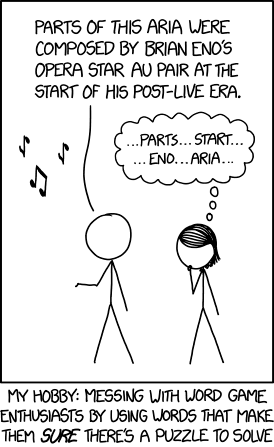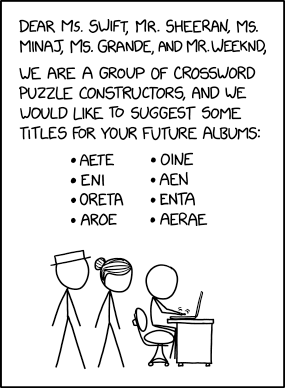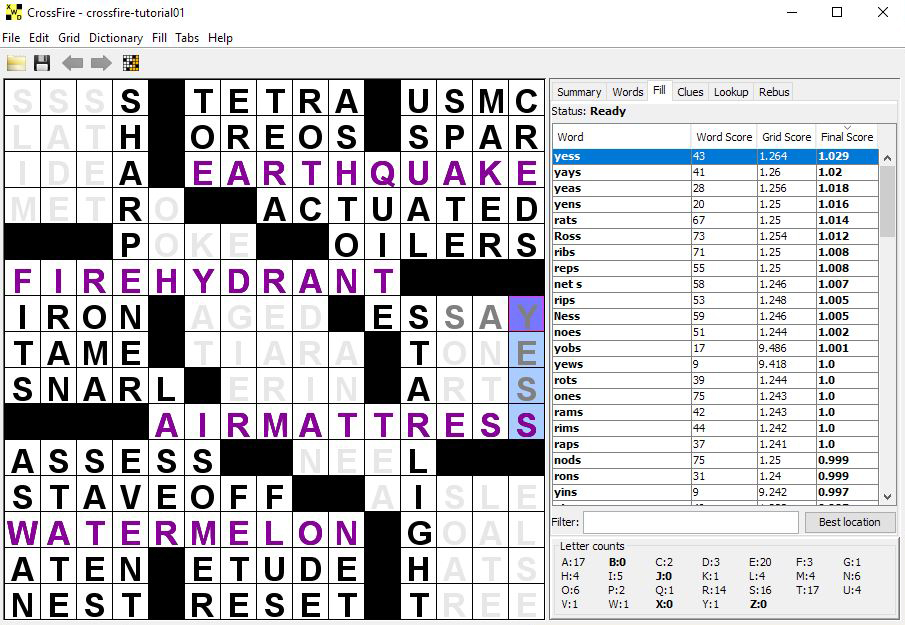Strategy | How to Find | How to Choose | Metrics | References
Strategy
- After initial grid layout, and theme entry placement, it's time to fill in other words.
- CrossFire:
Grid > Quick Filldemonstrates whether any solution is possible (albeit with some undesirable entries). - We plan to choose our own entries -- hopefully more fun, and recognizable with rough definitions in mind.
- However, we're not ready to start adding actual clues until the fill is complete and final.
- Berry (CCH) suggests the following strategy:
- 1. Fill slots that have the fewest possible fills first.
- 2. Fill slots that already contain some letters before filling empty slots.
- 3. Fill longer slots before shorter slots
- CrossFire:
Fill > Best Locationcan usually identify bottlenecks,
i.e., tight, constrained areas with fewest options, to focus on next. - As filling progresses, good later options generally become more limited.
- If this results in unsatisfactory options or dead ends,
change earlier choices via Undo or by reverting to an earlier saved version
-- or shift theme entry locations and/or tweak grid. - Even after grid is initially full, pause, review entries and subareas
-- any duplicate words? how many crosswordese? long repeated letter sequences?
any entries you dislike or regret? unsure about how to define some entries? - It may be possible to improve small areas without starting over -- another reason to wait to write clues.
How To Find Entries?
- Another common party question:...
- Pretend you're playing "Wheel of Fortune" -- recognize patterns and enumerate possibilities.
- Guide fill of selected areas using an app's built-in and add-on dictionaries -- or your own lists.
Note: some dictionaries contain typos, nonsensical words, etc. -- be sure to doublecheck validity. - If finding best fill candidates seems too slow in CrossFire, Ingrid can be much faster;
add the same dictionaries; set same word score cutoff;
open CrossFire file (.cfp) in Ingrid; compare fill suggestions for the same entries. - Find words that have been used in other crosswords, e.g., OneLook.com, OneAcross.com -- though not too often.
- CrosswordGiant.com: Search by Answer: answer entry/pattern (?) -> matching entries & clue
- XWordInfo: Finder ($; NYT only?): answer entry/pattern (?*) -> matching entries & clues
How To Choose From Possible Entries?
- Check Crossword Publication Specs for guidance, e.g.
- NYT: "Constructors should emphasize lively words, well-known names and fresh phrases.
Common words that lend themselves to interesting and imaginative cluing angles are encouraged.
Diversity in cultural references — for age, gender, ethnicity, etc. — is desired.
Avoid offensive language. Be mindful of words that might impact solvers negatively.
Non-English words are allowed, so long as they are familiar or inferable to people who don’t speak the language.
Avoid uncommon abbreviations and partial phrases longer than five letters
(“So ___” for BE IT would be permissible, while “So ___” for IT GOES would not.)
Keep crosswordese to a minimum — that is, answers that appear far more in crosswords
than in real life (ERNE, ASTA, ARETE, YSER, etc.).
Difficult words are fine — especially for the harder daily puzzles that run late in the week
— if the words are interesting bits of knowledge or useful additions to the vocabulary.
However, never let two obscure words or names cross." - LAT: "All answer words should be three letters or more,
and should contain only letters, not symbols or numbers.
Only one letter per square, please;...fresh vocabulary and witty wordplay." - WSJ: "filler words should be common, familiar, and lively.
You should avoid obscure words, crosswordese, and an
excess of abbreviations or partial phrases (like OUT ON).
Don’t overdo the number of proper names,
especially if they are all from a particular field (like sports or pop culture)" - Univ.: "Are all words/phrases things the average non-crossword solver could expect
to come across in real life (outside of a specific niche such as academia)?
Check your crossings for intersecting proper nouns (names, TV shows, songs,
brands, places, etc.) or other pieces of specialized vocabulary.
On a related note, try to avoid putting more than 2
“know it or you don’t” answers (or clues) in the same section.
Plurals of first or last names are generally discouraged (e.g., SARAS).
If you use a word from a language other than English,
it should be an introductory vocabulary word (hello, thank you, etc.).
There’s more flexibility with Spanish words due to the number of Spanish speakers in the U.S.
Avoid made-up words and phrases you wouldn’t expect to find in a dictionary
or commonly hear in conversation (e.g., PURPLE COMPUTER).
Uncommon forms or spellings of words (such as REHOE, EYER and ENURE) should be avoided.
We like to check the Google dictionary by typing “define ___” in Google search.
We are more likely to accept a word if it’s verified by Google.
Words marked as “archaic” or “literary” in the dictionary tend to be too tough.
Try to avoid partials (multi-word phrases that can only be clued with a fill-in-the-blank
because they’re not stand-alone phrases), especially if they’re longer than 3 letters.
For example, LAP OF can only be clued as [in the ___ luxury].
Try not to have multiple abbreviations in any one section.
Too many abbreviations and/or partials can make an area feel “goopy.”
Answers that could make solvers of any gender, ethnicity, sexual orientation
and/or ability level feel uncomfortable should be avoided.
Explicit references to sex, medical conditions, illegal drugs, bodily functions,
and generally unpleasant or violent things should also be avoided.
If you’re referencing a person in your puzzle, we suggest googling them to make sure they
don’t have allegations against them (accusations of misconduct, discriminatory speech, etc.)" -

Word Puzzles by XKCD is licensed
via Creative Commons
Attribution-NonCommercial 2.5 - "(2) crosswordese:...
- "(3) crosswordese:...
- Quiz: How Well Do You Know Your 'Crosswordese?' NYT; 11/28/2017
- Margaret Farrar (1st NYT crossword editor): good manners; no unpleasant or impolite language
- Word usage rules from Simon & Schuster in 1920s...
- "My biggest piece of advice for a puzzlemaker is...
- Use word 'scores' if available -- higher scores: more unique / lively;
lower scores: crosswordese or more obscure. - If auto-fill suggests an unrecognized entry,
check its definition to make sure it'll be 'clueable' later. - Use words/abbrev./acronyms that are mostly familiar to solvers -- but avoid overuse
- Some 'crosswordese' & abbrev. & proper names may be necessary for otherwise great fill,
but too much in an subarea becomes 'gluey' -- avoid initially, or refill later. - Crosserville provides an option that can flag problem areas:
Highlight Words Scored Below:value (originally called "Natick detector") - Longer words may be more interesting since they're used/seen less, e.g.:
"Six letters (the 'breakout length') -- that's the promised land...
- Diversity of references -- not too much specialized language
 The "NATICK Principle" was popularized by Rex Parker blogging about NYT: 7/6/2008:
The "NATICK Principle" was popularized by Rex Parker blogging about NYT: 7/6/2008:
"If you include a proper noun in your grid that you cannot reasonably expect
more than 1/4 of the solving public to have heard of, you must cross that noun
with reasonably common words and phrases or very common names." e.g.,
1A: Town at the eighth mile of the Boston Marathon [NATICK]
1D: "Treasure Island" illustrator, 1911 [NCWYETH]-

Crossword Constructors
Dear Ms. Swift, Mr. Sheeran, Ms. Minaj, Ms. Grande
and Mr. Weeknd, We are a group of crossword puzzle
constructors, and we would like to suggest some titles
for your future albums: AETE, OINE, ENI, AEN, ORETA,
ENTA, AROE, AERAE. Also, we would really appreciate
it if you could prominently refer to it as an 'eHit'.
Creative Commons Attribution-NonCommercial
2.5 License from xkcd.comAvoid crossing two entries of the same category, e.g., two sports clues, two opera clues, etc.,
since a solver (who knows neither) might not be able to fill-in the crossed square - Favor fill entries related to theme?
- Newer, evolving language: MEME, SIM, SEXT, TWEET, N.L. EAST,
NICKI MINAJ, LGBT, LOL, BARISTA, EDIBLE UNDERWEAR;
~Smithsonian: How Crosswords Came of Age in the 2010s - "In North America, crossword puzzle editors use what has come to be
known as 'The Breakfast Test'... - "And there's word-choice rules...
 Use Metrics
Use Metrics
- Choose entries with higher word rankings (dictionary scores),
and/or ones with higher grid scores: measure of 'neighborhood quality' / openness. - Check Statistics; eliminate duplicate words
and sometimes long (> 3) common letter sequences in entries. - CrossFire:
Summarytab: Avg. Score: quality of entries from dictionary values;
e.g., 'Great'(=60), 'Good' (=50), 'Fair' (=25), 'Poor' (=5)
-- higher 'better'; target?Letter counts: how many 'difficult' letters used?
some editors may like a few of J, Q, X, Z included;
some constructors vie for highest 'Scrabble score'Wordstab:
Score: word value from add-on dictionaries;
unusual theme answers may have zero score, if not in dict.;
try to replace lower score fill words?XScore: measure of ease of finding crossing entries; lower scores in harder grid areasShared Strings: 3-letter overlap (highlighted)
-- letter repetition may sometimes be ok for different word roots or contexts.- Submission Checker import .puz, .jpz, .ipuz;
report: Black squares, 3-letter words, Word count, Clue characters, Dupes (word overlaps) - Analyze puzzle: upload .puz -- for a report with various statistics?
e.g., schoOLLIfe example analysis;
symmetry; # circle & rebus squares; unique words; cheater squares;
Distribution of answer words by length; Letter distribution (frequency);
Answer words, which are not legal Scrabble entries, may be more interesting;
Theme uniqueness: puzzles that share
1) the most words with this one; 2) the unusual or long entries;
Puzzles with identical, or topologically similar grids;
"Scrabble score": letters used * tile value (w/o doubling/tripling) e.g., Highest NYT daily;
"Freshness Factor" = 100 - average of # occurrences of each answer word in NYT puzzles,
i.e., more unusual; NYT freshest

References / Examples
- How Word Lists Help -- or Hurt -- Crossword Puzzles NYT; 10/6/2021
- NYT: How to Solve The New York Times Crossword; interactive examples:
Fill-in-the-Blanks (FITB,'gimmes'); Tense; Part of Speech; Plural; Foreign Language;
Partner Clues; Cross Referenced; Abbreviations; Clues with a "?"; Slang;
"Quotes" and [Brackets]; Veiled Capitals; Heteronyms - NYT: Some common clue patterns; interactive examples:
Clue/Answer Agreement; Question Mark Clues; Crosswordese; Themes; Rebus Answers -

from: nytimes.com NYT: How to Make a Crossword Puzzle, Part 3: Filling the Rest of the Grid; How to make your entries sparkle
I’ve Got a Little (Word) List; Quality Is Never an Accident; But What About 'Crosswordese'?
Sunday Morning Breakfast Test (less rigid now, but generally avoid vulgarity, death. disease);
Start With the Most Constraints, Not the Least; Polish That Fill Until It Shines Like the Top of the Chrysler Building;
Am I Allowed to Change Things Around to Get the Best Fill? The Dreaded Duplication; Fussy About Fill - Crossword Constructor's Handbook (Berry) Chapter 3: Choosing Good Grid Entries (And Avoiding Bad Ones)
Pondering the Possibilities: Multiword phrases and hyphenated phrases; Famous people; Geographical locations;
Literature and the arts; Pop culture; Miscellaneous capitalized terms; Trademarks; Foreign words;
Acronyms and abbreviations; Prefixes and suffixes; Variant spellings; Roman numerals; Partials (parts of larger phrases);
Differentiating Good Entries from Bad Entries; crosswordese; Taking the offensive (out!);
Familiarity; Using obscure entries; Avoiding pseudo-familiar entries; Length; Rarity; Clueability -

from: nytimes.com Crossword Constructor's Handbook (Berry) Chapter 4: Filling the Grid
Filling Grids Manually; Common filling techniques: Alternating vowels and consonants;
Building stacks by adding adjacent layers; Mapping consonants and vowels; Dividing and conquering;
Changing your black-square arrangement; Digging for partials; Using gridmaking software for manual fills;
Filling Grids Automatically; Searching for 'duplicates' - The Art of Crossword Construction (Johnston): Filling the Grid: Fill sequence; Things to avoid in fill
- How Crossword Puzzles Are Really Made Gaffney; MF; 9/10/2014
-

from: beekeeperlabs.com (CrossFire) How to construct a crossword puzzle for the New York Times Alex Boisvert,
Crossword Nexus; video: 9:44; fill: @6:00; 4/23/2013; - WordPlay documentary: Merl fills other words: @0:19:19, @0:24:44
- Walkthrough: Making a Puzzle with CrossFire
- Example: OLLI (next subsection)
- CROSSWORDS and YOU: Vocabulary, Authoring
